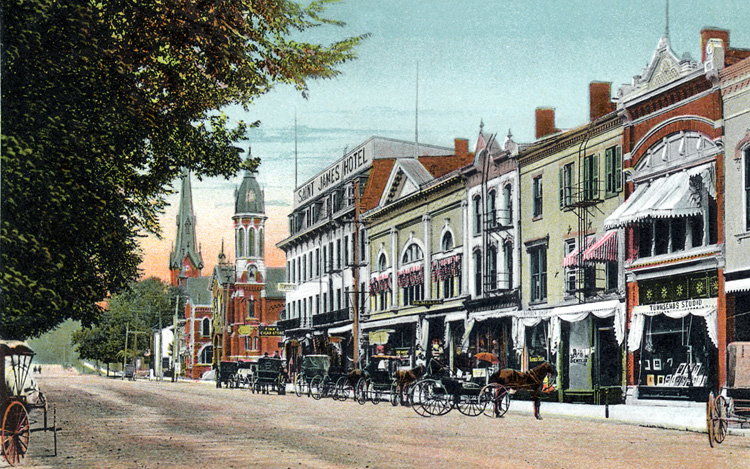
| JOHNSON COUNTY IAGenWeb Project |
Copyright 2004 By Bob Hibbs

A
Clinton Street image from the author’s collection elicits the warm,
elegant feeling of a summer afternoon
now nearly a century ago. The storefronts stretch north from near Washington Street opposite a
canopy of elms
reaching out from the University of Iowa’s Pentacrest
Campus.
|
By
Bob Hibbs Clinton
Street in Iowa City has changed considerably during the past century –
yet much remains the same, offering a fleeting wisp of glory. The
most obvious change: disappearance of the Byzantine-spire of Unity Hall
church building in favor of today’s boxy University of Iowa Phillips
Hall. In today’s image, Unity stands right of the Congregational
Church spire which still spikes the horizon at Jefferson Street. The
1869 Congregational edifice houses the
oldest local sanctuary still in use by the group which built it. Another
dramatic change is replacement of the St. James Hotel by the current Dey
Building housing the Iowa Book and Supply Store. The St. James is the four-story 1872
structure near the center of the image. Horse
and buggy rigs line the curb, creating a warm ambiance reminiscent of a
bygone era. So
does the grand sweep of the American elms reaching out from UI’s
Pentacrest. Most of these gorgeous specimen trees were lost during the
1960s, mostly to an imported beetle which spread Dutch Elm fungus. All
the structures showing south (right) of St. James exist today; albeit,
without the crispness of their youth. The
image recorded about 1907 resides on a full-color postcard in the
author’s collection. Iowa City’s population at that time totaled
about 9,000, and UI enrollment was 2,315 that fall. It
was a decade of strong local growth, from a 1900 census of 7,987 to
10,091 by 1910. The UI student body climbed from 1,542 to more than
2,100 during the period. It
was a decade before the newfangled horseless carriages began showing up
regularly on Iowa City streets. Before about 1917, cars were rare
sights, although one shows parked curbside at the Englert Theatre on its
grand opening Sept. 26, 1912; no doubt a showpiece to attract attention. Tents
were set up in Clinton Street between Iowa Avenue and Jefferson Street
for a grand car show by local dealers April 12-22, 1916, which the late
Iowa City historian Irving Weber described as dawning of the age of the
automobile in Iowa City. Weber,
who was born in 1900, wrote in 1984 that admission into the roped-off
car displays cost a quarter, compared with a dime to attend a movie. Unity
Hall was erected in 1872 – the same year as the St. James Hotel across
the street – as the Universalist Church’s stunning response to 12
years of homelessness after an 1860 fire razed its sanctuary a block
away in the southeast quadrant of the Iowa Avenue-Dubuque Street
intersection. Its
$17,500 cost and long-term maintenance eventually proved too great a
burden. When damaged by fire in 1896, local Universalists couldn’t
afford repairs, so gave the structure to their state convention. The
Universalists transferred it to the Iowa Unitarian Society three years
later, forever creating the mistaken belief that it was built by the
Unitarians, an error mitigated by their merger in 1961. UI
acquired the building in 1906, wore it out through a litany of uses,
then demolished it in 1932. Unity
and the St James took turns serving as the university’s student union,
first Unity during 1912 and 1913, followed by the St. James until it was
razed by fire in 1916. Union activities became a step-child until the
first section of IMU was opened in 1925. Back
in 1907 the St. James was still a vibrant institution, although beyond
its status as the city’s best hotel during the previous three decades.
Down around the corner across from a new Schaeffer Hall, the Imperial
Burkley Hotel was enjoying ascendancy. Rooms at the St. James were advertised at $1 a night, leaving unnoted the fact that the bathroom was down the hall as was typical of that era. A pitcher of water and a large bowl permitted one to freshening up before dinner.
Next
Saturday: Yet another
favorite antique postcard. Bob Hibbs collects local postcards and other historic ephemera and researches history related to them. |